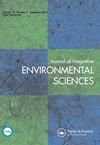The importance of non-CO2 greenhouse gases
IF 3.5
4区 环境科学与生态学
Q3 ENVIRONMENTAL SCIENCES
Journal of Integrative Environmental Sciences
Pub Date : 2015-12-02
DOI:10.1080/1943815X.2015.1118131
引用次数: 3
Abstract
The importance of non-CO2 greenhouse gases The IPCC Synthesis Report states that reducing emissions of non-CO2 agents can be an important element of global mitigation strategies. The non-CO2 greenhouse gas symposium (NCCG7) shows how this could be possible. Global warming is caused by several greenhouse gases. The focus of science and policy is mostly on carbon dioxide (CO2). But there are more greenhouse gases. Non-CO2 greenhouse gases are important contributors to radiative forcing of the atmosphere and include methane (CH4), fluorocarbons and SF6 and nitrous oxide (N2O). The effects of black carbon (BC) and the so-called indirect gases, contributing to tropospheric ozone formation and aerosols add to this list. The latest IPCC Synthesis Report states that the human influence on the climate system is clear and growing (IPCC 2014). It also states that implementing stringent mitigations activities can ensure that the impacts of climate change remain within a manageable range, creating a brighter and more sustainable future. To keep a good chance of staying below 2 °C our emissions should drop by 40–70% globally between 2010 and 2050, falling to zero or below by 2100. The chair of IPCC (RK Pachauri) added to this that “we have that opportunity, and the choice is in our hand” (press release, 2 November 2014). Ambitious emission reduction is possible, but the window for action is rapidly closing. Leo Meyer (PBL, The Netherlands and IPCC Technical Support Unit) indicates that 65% of our carbon budget compatible with a 2° warming goal is already used (Figure 1). This implies that if we want to limit global warming to 2°, some fossil fuels will have to stay underground (Pulles 2015). The economic consequences of such measure moderate. Business as usual scenarios typically assume an economic growth of a few percent per year. In scenarios consistent with a 2° warming this economic growth is hardly affected (Meyer 2014). Reducing emissions of non-CO2 agents can be an important element of mitigation strategies. However, the IPCC Synthesis report is not very explicit about how to achieve this. Emissions of non-CO2 gases (methane, nitrous oxide and fluorinated gases) contributed by about 27% to the anthropogenic global emissions of Kyoto gases in 2010. The week following the publication of the IPCC Synthesis Report, the 7th non-CO2 Greenhouse Gas Symposium (NCGG7) was organized. More than 200 scientists from all over the world presented their work. Following are some highlights from the conference. Several illustrative 2° scenarios exist according to Niklas Höhne (New Climate Institute; 2014). These typically assume that fossil CO2 emissions are reduced to zero and that CO2 from forestry is becoming negative (indicating a carbon sink). Non-CO2 greenhouse gases are typically stabilizing or slightly reducing, assuming that it will be difficult to reduce emissions of CH4 and N2O from food production. Nevertheless, about half of the avoided warming in a recently published 2° scenario is a result of avoided non-CO2 greenhouse gas emissions (Rogelj et al. 2014). According to Höhne it is possible to realize emission reduction scenarios that are consistent with a 2° warming (Blok et al. 2012). Non-CO2 GHG emission reductions initiatives can make a significant contribution if framed as opportunity, and alongside of reductions of CO2 emissions. Measures aimed at reducing short-lived climate forcers (such as black carbon, CH4 and fluorinated gases) are to be considered complementary rather than a substitute for early and stringent CO2 mitigation (Rogelj et al. 2014). Business-as-usual scenarios typically assume that greenhouse gas emissions keep increasing. However, NCGG7 presenters show that technologies exist to reduce emissions considerably. They argue that it is now a matter of policy and willingness. Bottom-up initiatives may fill the非二氧化碳温室气体的重要性
《政府间气候变化专门委员会综合报告》指出,减少非二氧化碳排放物可成为全球缓解战略的一个重要内容。非二氧化碳温室气体研讨会(NCCG7)展示了这是如何可能的。全球变暖是由几种温室气体引起的。科学和政策的焦点主要集中在二氧化碳上。但是有更多的温室气体。非二氧化碳温室气体是大气辐射强迫的重要贡献者,包括甲烷(CH4)、氟碳化合物、SF6和一氧化二氮(N2O)。黑碳(BC)和所谓的间接气体的影响,有助于对流层臭氧的形成和气溶胶的产生。最新的IPCC综合报告指出,人类对气候系统的影响是明确的,而且越来越大(IPCC 2014)。它还指出,实施严格的缓解活动可以确保气候变化的影响保持在可管理的范围内,创造一个更光明和更可持续的未来。为了保持在2°C以下的良好机会,我们的排放量应该在2010年至2050年间在全球范围内下降40-70%,到2100年降至零或以下。IPCC主席帕乔里(RK Pachauri)补充说,“我们有机会,选择权在我们手中”(新闻稿,2014年11月2日)。雄心勃勃的减排是可能的,但行动的窗口正在迅速关闭。Leo Meyer (PBL,荷兰和IPCC技术支持部门)指出,我们与2°变暖目标相一致的碳预算的65%已经被使用(图1)。这意味着,如果我们想将全球变暖限制在2°,一些化石燃料将不得不留在地下(Pulles 2015)。这种措施的经济后果是温和的。一切照旧的情景通常假定经济增长率为每年几个百分点。在与升温2°一致的情况下,这种经济增长几乎没有受到影响(Meyer 2014)。减少非二氧化碳剂的排放可成为缓解战略的一个重要组成部分。然而,IPCC的综合报告并没有非常明确地说明如何实现这一目标。2010年,非二氧化碳气体(甲烷、氧化亚氮和氟化气体)的排放量约占《京都议定书》气体全球人为排放量的27%。IPCC综合报告发表后的一周,组织了第七届非二氧化碳温室气体研讨会(NCGG7)。来自世界各地的200多名科学家展示了他们的研究成果。以下是会议的一些亮点。根据尼克拉斯Höhne(新气候研究所;2014)。这些通常假设化石二氧化碳排放量减少到零,而来自林业的二氧化碳正在变为负值(表明碳汇)。假设从粮食生产中很难减少CH4和N2O的排放,非co2温室气体通常会趋于稳定或略有减少。然而,在最近公布的2°情景中,避免的变暖中约有一半是避免非二氧化碳温室气体排放的结果(Rogelj et al. 2014)。根据Höhne,有可能实现与升温2°一致的减排情景(Blok et al. 2012)。如果将非二氧化碳温室气体减排举措视为机遇,并与减少二氧化碳排放一起,可以做出重大贡献。旨在减少短期气候强迫物(如黑碳、甲烷和氟化气体)的措施应被视为早期和严格的二氧化碳减缓的补充,而不是替代(Rogelj et al. 2014)。一切照旧的情景通常假设温室气体排放持续增加。然而,NCGG7的发言者表明,存在大量减少排放的技术。他们认为这是政策和意愿的问题。自底向上的计划可能会填补
本文章由计算机程序翻译,如有差异,请以英文原文为准。
求助全文
约1分钟内获得全文
求助全文
来源期刊

Journal of Integrative Environmental Sciences
ENVIRONMENTAL SCIENCES-
CiteScore
3.90
自引率
0.00%
发文量
13
审稿时长
>12 weeks
期刊介绍:
Journal of Integrative Environmental Sciences (JIES) provides a stimulating, informative and critical forum for intellectual debate on significant environmental issues. It brings together perspectives from a wide range of disciplines and methodologies in both the social and natural sciences in an effort to develop integrative knowledge about the processes responsible for environmental change. The Journal is especially concerned with the relationships between science, society and policy and one of its key aims is to advance understanding of the theory and practice of sustainable development.
 求助内容:
求助内容: 应助结果提醒方式:
应助结果提醒方式:


